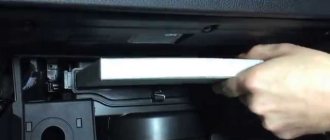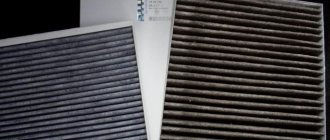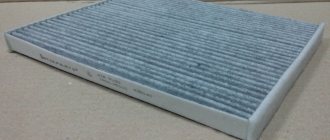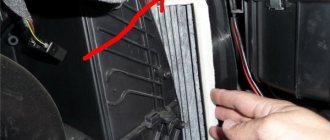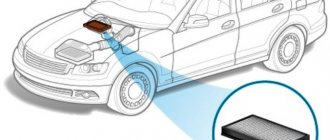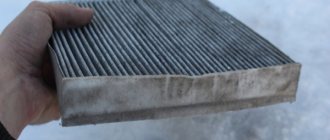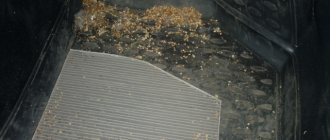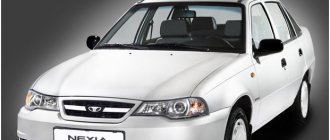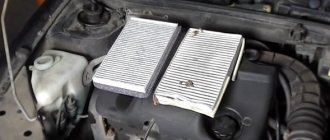Since the cabin filter appeared much later than other car components and assemblies, some users consider it a luxury item. This is not entirely true, because road safety depends on the driver’s well-being.
Cabin filter
The cabin uses an air conditioner and a heater, the radiators of which are very difficult and expensive to clean, much less replace. Finally, in megacities traffic jams without a cabin filter, the likelihood of poisoning from exhausts and hydrocarbon compounds increases by 6 to 12 times.
Purpose of the cabin filter
Even in the absence of traffic jams, the exhaust pipe of the front car is inevitably located in front of the hood of the car. The only barrier between the exhaust and the body of the driver and passengers are cabin filters of various designs and price categories.
Clogged heater radiator
The cleaner the air inside the car, the higher the service life of the air conditioner evaporator, radiator and heater fan.
Failure of the air conditioner evaporator due to clogged honeycombs
Concentration of harmful substances inside and outside the cabin
The need for a cabin filter is due to the following factors:
- the atmosphere of an average city contains CO, nitrogen and sulfur oxides, formaldehydes, hydrocarbons;
- the concentration of nitrogen dioxide at pedestrian crossings, roads and inside the car exceeds the maximum permissible concentration by 1.4, 3 and 7 times, respectively;
- in traffic jams this value increases to 15–20 times the maximum permissible concentration;
- road surface salts, soot and tire dust penetrate into the interior when the air cooling system fan operates.
Why do you need a cabin filter?
The main argument of used car owners is the lack of a cabin filter, even on old foreign cars. This is incorrect in principle:
- the number of cars before the 90s of the last century was significantly lower, accordingly, the concentration of harmful substances had not yet gone off scale;
- then the cabin filter appeared in executive cars, and later they began to be equipped with 85% of cars on the assembly line;
- The air filter is installed by default in the inlet air manifold, which does not raise any questions for the user, who understands that the entry of foreign particles into the fuel mixture is harmful to the engine.
The health of passengers and drivers, by default, has the highest priority in comparison with the car’s engine, so the cabin filter should not raise questions, but must be installed in any modern car.
Formaldehydes are colorless toxic gases that accumulate in the body and cause poisoning. Nitrogen oxides depress the respiratory tract and are retained only by activated carbon; paper and synthetics cannot cope with them. Carbon monoxide from incomplete combustion of hydrocarbons in the exhaust system is traditionally considered the most dangerous.
Methane, hydrogen sulfide, soot and benzopyrene enter the cabin in industrial areas of the city.
Operating principle
After installation, the cabin air filter works according to the following principle:
- completely covers the stove air intake opening, eliminating the suction of unfiltered air;
- excess moisture, dust and mechanical suspensions contained in the air settle on the paper cartridge;
- after treatment with chlorine, a paper dust filter additionally neutralizes some harmful bacteria;
- synthetic fibers of special cartridges have an electrostatic charge and firmly hold particles of dust and automobile rubber;
- paper impregnated with carbon solution partially retains dust smaller than 1 micron;
- Activated carbon in its pure form, poured between paper and synthetic layers of the filter, completely absorbs contaminants present in the air, that is, it not only binds, but also neutralizes them.
Operating principle of the cabin filter
Antioxidant coating designed for allergy sufferers. Paper, synthetic or carbon cartridges are coated with polyphenol, which eliminates odors.
Cabin filter design
Before you buy a carbon or regular cabin filter and install it yourself, you need to have an idea of the types, locations and installation methods. There are two modifications of the filter:
- cartridge - a curtain made of paper “folds”, shaped like a lattice installed across the air flow;
- cabinet - the curtain is installed in a frame and may have a handle for installation and dismantling.
Cartridge filter
Housing filter
The gratings around the perimeter of the curtain in the latter version provide spatial rigidity of the product, making it easier to install.
Barrier
Air flows are directed from outside into the cabin, so the filter must completely block the inlet manifold of the stove. Barrier or dust cartridges are paper cartridges that protect against insects, dust and pollen, soot, and other small particles.
Dust paper filter
They are made from paper by corrugation or pleating to multiply the working surface of the filter curtain. The main characteristics are:
- curtain surface area - depends on manufacturing technology, shape and number of curtains;
- throughput - indicates the percentage of penetration of particles larger than 0.3 microns through the curtain;
- aerodynamic resistance - the lower this indicator, the easier it is for air to penetrate into the cabin, measured before and after testing;
- dust capacity - shows the percentage of absorption of harmful particles until the aerodynamic resistance increases to 200 Pa, which is considered critical (the filter can be thrown away);
- price – barrier modifications are the cheapest existing options.
When installing a dust filter, the owner gets rid of ice on the glass from the inside of the cabin, fogging in the rain, and coarse dust. Provided that the original product is installed and not a counterfeit. If the dimensions of the filter do not correspond to the dimensions of the hole, then the air passes along the path of less resistance, that is, not through the curtain, but from the side. There is no point in such filtering.
Carbonic
Ideally, a carbon cabin filter is assembled from curtains filled with coconut carbon. In practice, wood activated carbon or impregnation of paper with a carbon solution is more common. When purchasing you should consider:
- carbon impregnation has a density of 300 - 350 g/m2 maximum, has weak absorption;
- Bulk coal has a density of 700 g/m2 and is guaranteed to meet the filtration characteristics declared by the manufacturer.
Carbon filter from the inside out
Currently, it is almost impossible to buy filters with natural carbon; their price starts from 5 – 7 thousand rubles. To reduce costs, manufacturers switched to products made from paper impregnated with carbon solution. The filter became cheaper (1200 - 3000 rubles), but lost in efficiency.
Carbon impregnation is lighter and less effective
Electret
If the barrier filter additionally contains a layer of non-woven synthetic material, such modifications are called electret. This fabric has a static charge and attracts particles of dirt and foreign substances from the air.
Electret filter
For example, if I choose a curtain with non-woven material, in addition to purifying the air from large mechanical particles, the cabin filter will retain fine dust, fungal spores and pollen.
Combined
Unlike single-component curtains, combined filters can contain any combination of:
- paper cartridges;
- electret fabric;
- a layer of coal or paper carbon impregnation.
Combination filter
This allows you to dramatically improve the air quality inside the cabin, the service life of the air conditioner and heater. In combination cartridges, paper is usually installed at the input, synthetics are behind it, and the last layer is made of activated carbon.
Antibacterial fabric
Test results
In terms of efficiency, the LX 2010 filter element (Mahle) showed the best results. This can be explained by the high filtering properties of the material used in its manufacture. And in combination with other parameters, this filter can be considered the best in the entire group of tested samples.
In second place, but only in terms of filtration efficiency, is Fram. Despite the difference of only 0.01%, this example is very far from the first. It showed the lowest dust capacity (107.6 grams). This can be explained by using a material that is too dense for a curtain of this size. With such a high initial resistance as this sample, the result could not have been different.
The Sakura filter showed good efficiency - at the level of 99.2%. But, as can be seen from the dust holding capacity (111 grams), this parameter was achieved due to a significant reduction in the efficiency of the resource. Perhaps, in this case, this result was obtained not due to the parameters of the curtain material, but due to the low filtration area. For this sample it is minimal.
Next in efficiency is BIG Filter with a value of 99.18%. It fell behind third place by 0.02%, but with a mass of accumulated dust of 181.5 grams. In general, a decent result in terms of all parameters.
In fifth place is Bosch with an efficiency of 99.12% and a dust capacity of 135 grams. Such mediocre results can be explained by the poor design of the filter curtain. This sample has the maximum filtration area of all presented. It was achieved due to a large number of corrugations, which during installation leads to a significant compaction of the “pockets” and, as a consequence, high initial resistance and reduced service life.
Filtron result is 99.11%. But its dust capacity is much higher - 144.3 grams. The low dust capacity compared to previous samples can be explained by the small filtration area of the curtain and the material with average parameters.
In seventh place is Champion with an efficiency value of 98.61. This value is on the verge of the permissible value of the final efficiency of a car filter (99%). This result, taking into account the dust holding capacity of 191.1 grams, can be explained by the use of mediocre material for making the curtains - the pores in the paper are too large for this size and design.
The lowest efficiency, to our great surprise, was shown by Mann-Filter - 96.73%. It is difficult to say what caused such poor results from such a well-known brand. In all other respects, the sample looks quite decent. Its dust capacity is simply deafening - 234.6 grams! It is possible that there was a defect in the sample that was not detected during an external examination, so a detailed study is necessary to establish all the reasons. But it is preferable to test a new sample, or even better, three samples, and then draw a conclusion about this model.
Installation location
Car manufacturers typically install cabin filters in three possible locations:
- under the hood - more precisely, near the partition of the engine compartment, access of medium complexity, usually cabinet options for curtains;
- near the glove box - behind the glove compartment or under it, easy access, both case and cartridge modifications are used;
- near the steering column - under the dashboard or on top of it, in the first case access is difficult, in the second it is easy, cartridge options are usually used;
Filter location under the hood
Cartridge behind glove compartment
Cartridge under dashboard
Unfortunately, when choosing a vehicle, the owner cannot predict the location of the cabin filter in advance. Since the performance of the machine is much more important than the maintenance of filtration equipment.
For example, in Chevrolet Lanos and ZAZ with a similar body, the cabin filter is conventionally located under the hood. However, getting to it is very difficult:
- you will have to dismantle 4 clips and remove half of the plastic air intake panel on the passenger side;
- pull out and remove another plastic part from the air intake hatch;
- climb onto the engine to reach the filter cover;
- remove it and carefully place the new product, inserting almost your entire arm up to the shoulder into the opening;
- install the water intake panel without damaging the left edge extending beyond the hood cover.
ZAZ and Lanos filter location
However, when located under the dashboard, the situation is even worse, which is why periodic replacement is not carried out by the owners.
DIY replacement
When operating a vehicle, experts recommend choosing a schedule for replacing the cabin filter curtain/cartridge along with an oil change, that is, after 7–10 thousand kilometers. It should be noted that even in parking mode this filter becomes clogged, but to a much lesser extent.
Filter life
The main reasons for replacing the cabin filter are:
- icing of glass from the inside in winter or excessive fogging in summer;
- foreign odors in the cabin, penetration of exhaust from cars in front;
- weakening of air pressure from the heater;
- clogging of the air conditioner evaporator honeycomb;
- mileage more than 10,000 km or a year of operation with irregular trips, in parking mode.
When located under the dashboard, drivers remember about the cabin filter, it’s good if once a year - in the spring. It is at this time that odors and poplar fluff begin to penetrate into the cabin.
Replacement under the steering column
Usually the cartridge in this version is hidden under the panel. Moreover, the best car manufacturers equip the car with 2 – 3 cabin filters at once. The maintenance budget and labor intensity of work increases, but all you need is a shaped screwdriver.
Using the example of the Nissan Qashqai, in which the cassette is located to the right of the gas pedal, you need to perform the following sequence of actions:
- release the clip latches;
- dismantle the decorative trim of the central tunnel;
- remove the cover from the box, also secured with latches;
- remove the cartridge by squeezing it with your fingers;
- install a new curtain, first pressing it with your fingers;
- assemble the panel cladding in the reverse order using the latches.
Replacing the cartridge under the steering column
Attention: Depending on the configuration and size, the filter may be installed on a certain side of the cartridge or housing. Manufacturers usually indicate with markings on the box or in the instructions the side facing outward and inward.
Replacement behind the glove box
Traditionally, to divide cars into price segments, it is much easier for owners of luxury foreign cars to replace the cabin filter. For example, in the Toyota Corolla, the glove box folds down completely by pressing the side latches. This opens access to the cartridge, protected by a special cover, which is secured with two latches.
The cassette will also have to be pressed during removal and when installing a new curtain. On other modifications of cars, it may be necessary to remove the glove compartment and unscrew the cartridge cover screws with a screwdriver.
Replacing the cartridge behind the glove compartment
Replacement under the hood
The cabin air filter is always located behind the wall of the engine compartment, but in models from leading automakers the design is thought out to the smallest detail, and in some cars several additional parts will have to be removed.
For example, in the BMW X5 series, the cover latches are removed manually; there is no need to use a screwdriver; the curtain can be pulled out conveniently and quickly.
Replacing the cabin filter under the hood using the example of a BMW X5
On VAZ cars of the “tenth” series, the replacement process is more labor-intensive and lengthy:
- dismantling windshield wipers (“wipers”);
- removing the polymer air intake panel (4 self-tapping screws under the decorative plugs);
- dismantling the decorative trim of the engine compartment partition (8 screws for a figured screwdriver and 2 nuts in the corners);
- the air intake compartment is located on the passenger side, and the cartridge is installed vertically inside it on the driver’s side;
- After removing the filter, you need to remove large debris that has accumulated there during operation and vacuum away small debris.
The cartridge fastening is not provided here; it is inserted by surprise into the existing hole.
Replacing the VAZ 2110 cartridge
Coal option
There is a lot of information on the Internet about how to make it yourself, as well as how to extend the life of what you already have. What enterprising car owners don’t do: they put nylon stockings on it, stuff it with napkins and foam rubber, vacuum it, etc.
It is absolutely impossible to do any of the above, since the filter elements operate in a hot and humid environment and also absorb fats. Therefore, it is not known how nylon or foam rubber will behave in this situation.
Carbon filter for your car's interior
In order to make a cabin filter with your own hands, you will need:
Homemade filter stage 1
Such a mesh can be purchased at a regular market or at a car dealership. It is most often used to decorate air intake grilles.
Instead of mesh, you can use any other material, but it is very important that the final structure is rigid and durable.
Homemade filter stage 3
The entire procedure will take no more than an hour. And in the future you will only have to replace the canvas, since you have already placed the frame in the frame. You can use your remaining piece of carbon sheet again to replace the material in the frame.
This example describes the case of replacing a filter cloth in a plastic frame; in some modern cars the frame is made of pressed cardboard or, in general, there is none, in this case you will have to additionally add structural rigidity.
Original, alternative and counterfeit filter
By default, the original cartridge costs 20–50% more than analogues from third-party manufacturers. You need to order it and wait, which is not always convenient for the car owner. Analogues differ from counterfeit products in the following parameters:
- distortion of real characteristics or their absence in the description or on the packaging;
- smaller in size than the original, so filtration does not occur in full.
Analogs have standard sizes and are made from cheaper materials, but information about this is always provided by the manufacturer. These modifications are always available at a budget price. Craftsmen buy cheap counterfeit goods and seal the cracks with rubber and foam gaskets. Then the filters are additionally protected with metal and nylon meshes from large debris entering the air intake compartment.
Protecting the air intake grille with mesh
Test method
The air filter test bench is built according to the ISO 5011 standard used to test these components - and uses all testing methods.
The filter being tested is installed in its original housing (ideal for testing). Next, using a fan, the injection of rarefied air is simulated, as during normal movement. The air flow should be what the engine uses at rated power.
First parameter
— initial resistance. (auxiliary, directly involved in determining dust capacity) It demonstrates what resistance the filter has to air flow, how “easy it is to breathe” for an engine equipped with such a filter. Its value directly determines the life of the filter element. The higher this value, the lower the resource. The initial resistance depends solely on the design of the engine air path, the size of the window covered by the filter element, the material used to make the curtain, and its parameters (the size of the corrugations and their number). Since the comparative tests used the same housing, adapters and feeder, the factors determining the initial resistance were the curtain material, the dimensions of the corrugations and the quality of workmanship.
Second parameter
- dust capacity. This is, in fact, a resource as such. This parameter has no lower limit. In principle, there is no upper one either, but the higher this indicator, the better. The car manufacturer regulates it with the requirement “not less than...”. The key factor determining this parameter is the filtering surface area of the curtain. As an integral indicator, it evaluates its shape, geometry and dimensions. The second most important factor is the properties of the curtain material (air permeability, average and maximum pore size). The division into “first” and “second” factors is very arbitrary in importance, since they largely influence one another. Geometry is determined earlier during design purely chronologically, which is why in this description this factor is declared first.
Third parameter
— filtration efficiency. It shows how much dust supplied to the input was retained by the filter. The higher this parameter, the better. In terms of significance, it is more important than the previous two; when comparing filter elements, it is rated first, and only with equal efficiency values can these elements be compared in other parameters.
